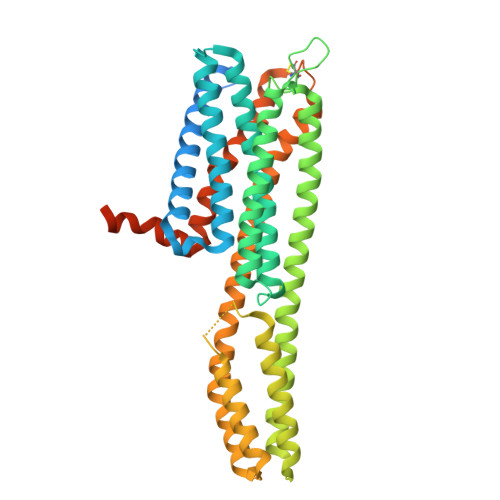Structural insights into the high basal activity and inverse agonism of the orphan receptor GPR6 implicated in Parkinson's disease.
Barekatain, M., Johansson, L.C., Lam, J.H., Chang, H., Sadybekov, A.V., Han, G.W., Russo, J., Bliesath, J., Brice, N.L., Carlton, M.B.L., Saikatendu, K.S., Sun, H., Murphy, S.T., Monenschein, H., Schiffer, H.H., Popov, P., Lutomski, C.A., Robinson, C.V., Liu, Z.J., Hua, T., Katritch, V., Cherezov, V.(2024) Sci Signal 17: eado8741-eado8741
- PubMed: 39626010
- DOI: https://doi.org/10.1126/scisignal.ado8741
- Primary Citation of Related Structures:
8T1V, 8T1W, 8TF5, 8TYW - PubMed Abstract:
GPR6 is an orphan G protein-coupled receptor with high constitutive activity found in D2-type dopamine receptor-expressing medium spiny neurons of the striatopallidal pathway, which is aberrantly hyperactivated in Parkinson's disease. Here, we solved crystal structures of GPR6 without the addition of a ligand (a pseudo-apo state) and in complex with two inverse agonists, including CVN424, which improved motor symptoms in patients with Parkinson's disease in clinical trials. In addition, we obtained a cryo-electron microscopy structure of the signaling complex between GPR6 and its cognate G s heterotrimer. The pseudo-apo structure revealed a strong density in the orthosteric pocket of GPR6 corresponding to a lipid-like endogenous ligand. A combination of site-directed mutagenesis, native mass spectrometry, and computer modeling suggested potential mechanisms for high constitutive activity and inverse agonism in GPR6 and identified a series of lipids and ions bound to the receptor. The structures and results obtained in this study could guide the rational design of drugs that modulate GPR6 signaling.
Organizational Affiliation:
Bridge Institute, USC Michelson Center for Convergent Biosciences, University of Southern California, Los Angeles, CA 90089, USA.















